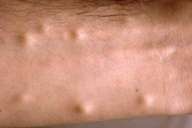Steatocystoma multiplex
Published Web Location
https://doi.org/10.5070/D328s7d513Main Content
Steatocystoma multiplex
David H Chu MD PhD
Dermatology Online Journal 9(4): 18
From the Ronald O. Perelman Department of Dermatology, New York University
Abstract
A 25-year-old man with a 20-year history of asymptomatic nodules on his arms and trunk, which histopathological analysis showed to be consistent with steatocystoma multiplex, is presented. Steatocystoma multiplex is a disorder characterized by multiple, asymptomatic, dermal cysts that usually occur on the trunk and proximal aspects of the extremities. Steatocystoma multiplex with acral predominance has only recently been described. Development of steatocystomas has been hypothesized to be due to alterations in the structure of keratin 17. Treatment for lesions has included surgical excision or drainage, oral retinoids, and liquid nitrogen cryotherapy.
Clinical summary
History.—A 25-year-old man presented with a dermatosis involving the arms, chest, and abdomen. The patient presented with a 20-year history of asymptomatic nodules, which initially appeared on his chest and which began to spread to his arms over the last 7 years. He denied that they had ever become painful or infected. He stated that he had punctured one in the past, which yielded white, semisolid material. He had never been treated for his condition. A skin biopsy was performed to confirm the suspected diagnosis. He denied that any of his family members had similar lesions.
Past medical history includes acne vulgaris and hepatitis-B virus infection. Medications include tetracycline and a multivitamin.
Physical examination.—Numerous, skin-colored, 0.5-1.0-cm papules and nodules were present on the flexor surfaces of both arms, with fewer lesions located on the chest and abdomen. There were no nail changes.

|

|
| Figure 1 | Figure 2 |
|---|
Laboratory data.—Liver function transaminase levels, total bilirubin, and alkaline phosphatase were normal.
Histopathology.—There are portions of the cyst wall with a corrugated luminal surface associated with an eosinophilic cornified layer and absence of the granular layer.
Diagnosis.—Steatocystoma multiplex.
Comment
Steatocystoma multiplex is a disorder characterized by multiple, asymptomatic, dermal cysts that usually occur on the trunk and proximal extremities and less commonly on the neck, axillae, inguinal region, and scalp. Acral steatocystoma multiplex, in which involvement of the extremities is more prominent than that on the trunk, is uncommon and has been only recently described [1].
Onset of the disease tends to occur during adolescence or early adult life. This disorder has a predominantly autosomal dominant mode of inheritance, although many sporadic cases have been reported.
Keratin 17 has been proposed to be an important factor in the formation of familial steatocystomas. Missense mutations in the helix boundary motifs of this protein have been found in a number of pedigrees of patients with familial steatocystoma multiplex as well as pachyonychia congenital type 2 (Jackson-Lawler syndrome) [2, 3]. Keratin 17 is expressed in several epithelial structures, most notably in the nail bed, hair follicles, and sebaceous glands, which is a distribution that is consistent with the affected tissues in patients with these diseases. In sporadic cases of steatocystoma multiplex, similar mutations in keratin 17 have not been found, an observation that suggests a multifactorial basis for this disease [2].
Most lesions of steatocystoma multiplex remain asymptomatic, although some lesions may become inflamed, rupture, and drain. Treatment of noninflammed lesions is most successfully achieved with surgical excision or drainage [4]. Limited success has been reported with the use of both oral retinoids and liquid nitrogen cryotherapy for treatment of suppurative lesions [5].
References
1. Rollins T, et al. Acral steatocystoma multiplex. J Am Acad Dermatol 2000;43: 396.2. Covello SP, et al. Keratin 17 mutations cause either steatocystoma multiplex or pachonychia congenital type 2. Br J Dermatol 1998;139:475.
3. Smith FJD, et al. Missense mutations in keratin 17 cause either pachyonychia congenita type 2 or a phenotype resembling steatocystoma multiplex. J Invest Dermatol 1997;108.
4. Schmook T, et al. Surgical pearl: Mini-incisions for the extraction of steatocystoma multiplex. J Am Acad Dermatol 2001;44:104.
5. Apaydin R, et al. Steatocystoma multiplex suppurativum: oral isotretinoin treatment combined with cryotherapy. Australas J Dermatol 2000;41:98.
© 2003 Dermatology Online Journal

